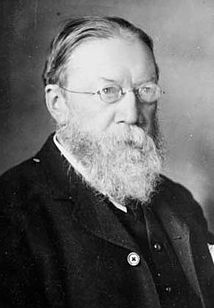| 1891
Census |
Gothic Lodge, South Side
Wimbledon Common, Wimbledon, Kingston, Surrey
|
| William H |
Preece |
Head |
W |
57 |
Electrician
post office civil service |
Caernarvonshire,
Wales |
| Jane E |
Preece |
Sister |
S |
71 |
- |
Caernarvonshire,
Wales |
| Agnes |
Preece |
Daughter |
S |
26 |
- |
Southampton,
Hampshire, England |
| Arthur |
Preece |
Son |
S |
23 |
Electrical
engineer |
Southampton,
Hampshire, England |
| Mary F |
Preece |
Daughter |
S |
22 |
- |
Southampton,
Hampshire, England |
| Percy |
Preece |
Son |
S |
20 |
Student
in law |
Southampton,
Hampshire, England |
| Frank Hugh |
Preece |
Son |
S |
18 |
Student
engineer |
Southampton,
Hampshire, England |
| Amy |
Preece |
Daughter |
S |
17 |
- |
Southampton,
Hampshire, England |
| Harriet E |
Bedwell |
Servant |
S |
38 |
Cook
|
Mansfield,
Sussex
|
| Charlotte |
Swan |
Servant |
S |
25 |
Parlourmaid
|
Denham,
Kent, England
|
| Sarah A |
Brown |
Servant |
S |
23 |
Housemaid
|
Basingstoke,
Hampshire
|
| Celia M |
Thornton |
Servant |
S |
17 |
Kitchen
maid
|
Lambeth,
Surrey
|
|
In view of the immense
calls on his time, William Henry decided to set up as a
full-time consulting engineer around 1898, his two
eldest sons Llewellyn and Arthur joining him, and his
friend Major Philip Cardew would be his senior partner.
William Henry finally
retired from the Post Office on 15 February 1899, and
was subsequently made the first Freeman of Caernarvon,
which he was presented with on 21 September that same
year. He was made a Knight Commander of the Order of the
Bath (KCB) in the Queen's Birthday Honours list, an
award that his son Arthur Henry also received in the
1932 Honours List.
His third son Frank was
reported as working as an electrical engineer but no
longer lived in the Home Counties. He was at Caernarvon
with Arthur and Llewellyn when his father was
inaugurated as a Freeman, having travelled from
Liverpool. Percy, the youngest son, followed his
maternal Grandfather's profession and became a
solicitor.
Messrs Preece and
Cardew leased offices in 1899 at 8 Queen Anne's Gate,
overlooking St James Park. William Henry became a member
of the Board at the London Electricity Supply Company,
and chairman of the British Coalite Company. He also served as President of the Institution of
Civil Engineers 1898-9.
In 1901, he was elected Chair of the Society
of Arts, having been a member for over 20 years, and
was re-elected in 1902.
|
| 1901
Census |
Gothic Lodge, South Side
Wimbledon Common, Wimbledon, Kingston, Surrey
|
| William Henry |
Preece |
Head |
W |
67 |
Civil
engineer |
Caernarvonshire,
Wales |
| Jane Elizth |
Preece |
Sister |
S |
81 |
- |
Caernarvonshire,
Wales |
| Agnes Ewen |
Preece |
Daughter |
S |
36 |
- |
Southampton,
Hampshire, England |
| Amy |
Preece |
Daughter |
S |
27 |
- |
Southampton,
Hampshire, England |
| Flora Jane |
Borley |
Servant |
S |
27 |
Cook
|
Suffolk,
England |
| Fanny Violette |
Clapton |
Servant |
S |
36 |
Parlourmaid
|
Minster
Lovell, Oxfordshire, England |
| Ada Ann |
Clapton |
Servant |
S |
25 |
Parlourmaid
|
Minster
Lovell, Oxfordshire, England |
| Fanny |
Johnson |
Servant |
S |
31 |
Housemaid
|
Boreham,
Essex, England |
| Ella Adela |
Wilson |
Servant |
S |
16 |
Kitchenmaid
|
Gravesend,
Kent, England |
|
